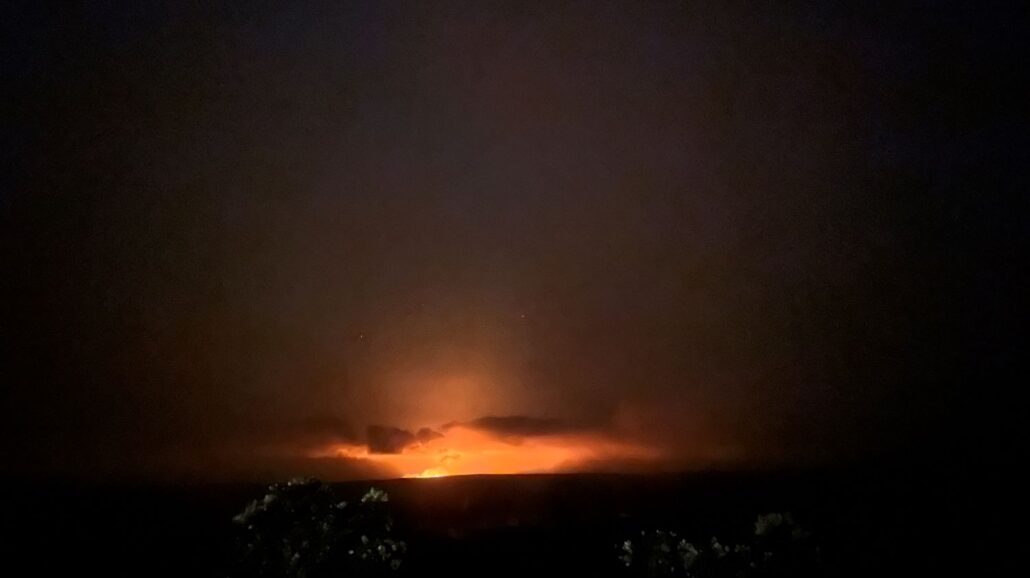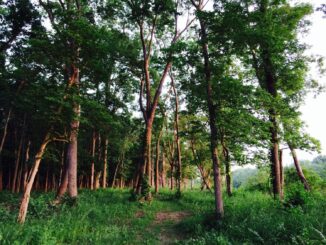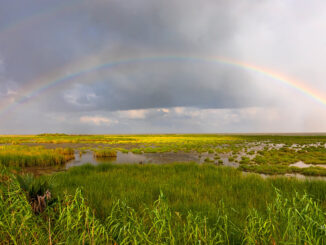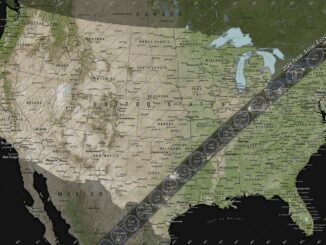
Kilauea, the most active volcano in the United States and one of the top active volcanoes in the world, erupted again early Monday.
The eruption was reported to have subsided later in the day but seismic activity could still be detected.
The US National Park Service says the eruption occurred in a remote corner of Hawaii Volcanoes National Park closed to the public. NPS said lava spurted out from fissures in the ground.
NPS and the US Geological Survey (USGS) are closely monitoring the eruption.
“The fissure eruption is in a remote area about 2.5 miles (4 km) southwest of Kilauea caldera and is not accessible,” NPS said. “Park rangers and scientists with the U.S. Geological Survey Hawaiian Volcano Observatory continue to assess eruption conditions.”
The Park Service says public viewing of the eruption site isn’t possible for the time being.
“No safe lava-viewing locations have been established at this time,” the Park Service added, though it noted that a “beautiful red-orange lava glow” could be seen before sunrise Monday from sections of the Crater Rim Trail.
With news of the eruption hitting the national media, NPS is expecting an increase in the number of visitors to Hawaii Volcanoes National Park in the coming days as folks hope to catch a glimpse of the eruption.
However, officials there are stressing that, for now, lava from the eruption isn’t visible to the public.
The most popular parts of the park are still open.
“Stump rocket”
So far, the impact of this current eruption is deemed to be minimal. That wasn’t the case in 2018 when a major eruption cycle destroyed more than 700 houses on Hawaii’s Big Island and completely filled in a popular snorkeling bay with lava.
The 2018 eruption of the Kilauea volcano was the result of a volcanic mechanism never seen before, scientists are now saying in a new study.
They’re likening the physics behind the 2018 Kilauea caldera eruption to a “stomp rocket” toy.
Researchers say an explosion of gas, ash, and lava most likely occurred when the mountain collapsed in on itself, squeezing gas and ashes out the other end, much in the way jumping on an air-filled bottle rapidly forces air through tubes to launch a paper or foam toy rocket at the other side.
The authors of the new study, published in the journal Nature Geoscience, claim this is the first time such a volcanic eruption had been recorded.
Lava flows from the 2018 Kilauea eruption destroyed some 700 houses and filled Kapoho Bay, once a popular snorkeling site.
“Explosive eruptions are typically driven by either rising molten rock (magma) or by expanding steam from magma heating underground water,” the research team reported in a release. “However, geologists have identified 12 eruptions of Kilauea in May 2018 that can’t be explained by those mechanisms.”
Through analyzing data collected during the eruption that occurred six years ago and running three-dimensional computer models, scientists said they’ve determined how pressure likely moved through the underground chambers that fueled the eruption.
Their research indicated that the changes and movements in pressure and the resulting explosions “are consistent with the collapse of the magma reservoir suddenly increasing the pressure of gas trapped in the chamber and leading to an explosive eruption like a stomp-rocket toy, which contains a gas-filled cavity that, when stomped on, shoots a toy rocket into the air.”
The 2018 event involved 12 separate eruptions at the active volcano. The eruptions also created fissures in the earth that spewed lava into the air and downhill. The subsequent lava flow destroyed hundreds of homes.
Though this is like the first “stomp rocket” volcanic eruption confirmed by scientific research, the authors caution that this kind of eruption almost certainly isn’t unique to Kilauea.
They hope their findings will help lead to improved volcano warning systems.
“Understanding the dynamics of plume formation from collapse-driven eruptions could help with forecasting hazards to aviation and local populations,” they argued.
New eruption follows closures
Ahead of this latest eruption, several parts of Hawaii Volcanoes National Park had been closed for weeks following a series of minor earthquakes. The US National Park Service said it closed certain areas out of an abundance of caution.
NPS recently announced that Chain of Craters Road and other parts of the park had reopened “as unrest and seismicity return to normal levels in Kilauea volcano’s upper East Rift Zone.”
Regardless of conditions and eruption predictions, the Park Service still warns that Kilauea remains “one of the most active volcanoes on Earth.” Visitors should be aware that conditions can change with little to no notice.
The Kilauea volcano is one of the main attractions at Hawaii Volcanoes National Park.
©2025 Public Parks
Park Info
Park:
Hawaii Volcanoes National Park
Location:
Hawaii, USA
More Information:



